 What makes a dark beer dark? It all comes down to the malts. Though all beer relies on malts (cereal grains that have been allowed to germinate, then dried to halt the germination process), dark beers are unique in their use of black and dark malts. These grains are heavily roasted to achieve the characteristic color as well as the caramelized, toasty flavors we love. The blanket term “dark beer” encompasses everything from classic styles like schwarzbier (a dark German lager) to the relatively new and trendy black IPAs. The most familiar dark beers, however, are generally billed as either porters or stouts. As it turns out, the line between those two styles is rather blurry indeed, and many argue that there is no practical difference at all. Historically, stouts evolved from porters, with English brewers aiming to create a “stouter” version of their country’s beloved porter beers. Though the two styles often overlap, today’s stouts still tend to be a bit bolder and stronger than easy-drinking porters. Within those two broad categories is a range of styles to suit any palate. Peaks and Pints presents an in-house flight of dark beers that we call Peaks and Pints Beer Flight: Dark Beers.
What makes a dark beer dark? It all comes down to the malts. Though all beer relies on malts (cereal grains that have been allowed to germinate, then dried to halt the germination process), dark beers are unique in their use of black and dark malts. These grains are heavily roasted to achieve the characteristic color as well as the caramelized, toasty flavors we love. The blanket term “dark beer” encompasses everything from classic styles like schwarzbier (a dark German lager) to the relatively new and trendy black IPAs. The most familiar dark beers, however, are generally billed as either porters or stouts. As it turns out, the line between those two styles is rather blurry indeed, and many argue that there is no practical difference at all. Historically, stouts evolved from porters, with English brewers aiming to create a “stouter” version of their country’s beloved porter beers. Though the two styles often overlap, today’s stouts still tend to be a bit bolder and stronger than easy-drinking porters. Within those two broad categories is a range of styles to suit any palate. Peaks and Pints presents an in-house flight of dark beers that we call Peaks and Pints Beer Flight: Dark Beers.
Peaks and Pints Beer Flight: Dark Beers
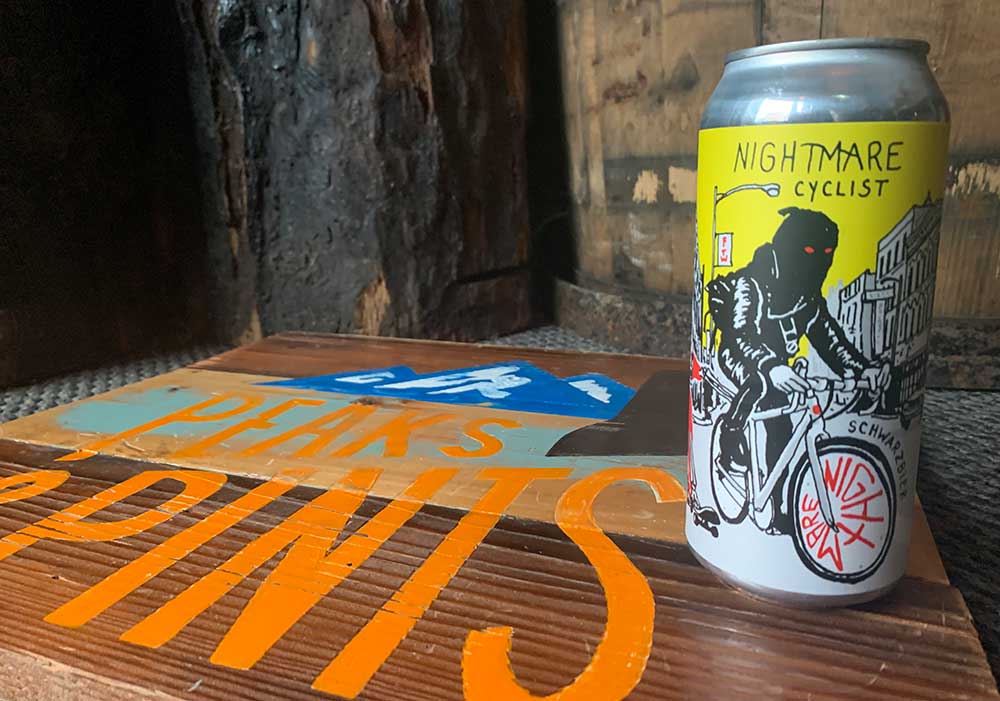 Wander Nightmare Cyclist
Wander Nightmare Cyclist
5.5% ABV
Schwarzbier is one of the oldest known European beer styles, with origins in Kulmbach, Germany, circa 800 BC. Pronounced sh-vahts bee-uh, this lager style is named after its appearance, similar to other German lagers. Schwarzbier translates to black beer and may seem unapproachable, but the reality is quite the opposite. The body of schwarzbier is as light as any mass-produced lager you’ll find; the ABV is pretty much the same as well. The only difference is that the malted barley used in the beer was roasted before it was added to the mash. This changes the color, sure, and adds toasty coffee and chocolate flavors to the finished product but does not affect the thickness of the liquid or the alcohol content. Some dry roasted coffee tones are also characteristic, but schwarzbiers should not have a burnt-bitter or astringent taste. They will have low hoppiness and are considered a well-balanced beer. Wander Brewing released a terrifyingly delicious schwarzbier brewed collaboratively at great distance with their friends Solemn Oath Brewery in Naperville, Illinois. “Smooth, rich German malt unapologetically cut off by two wheels of bright Czech Saaz. A beautiful symphony of chaos, just in time for the holiday of horror,” states Nightmare Cyclist hype. It’s delicately bitter, allowing the roasted malts to balance in their own way. It’s very much akin to a light porter, and the bittersweet chocolate and not-burnt, softly coffee-like roastiness lingers in the finish.
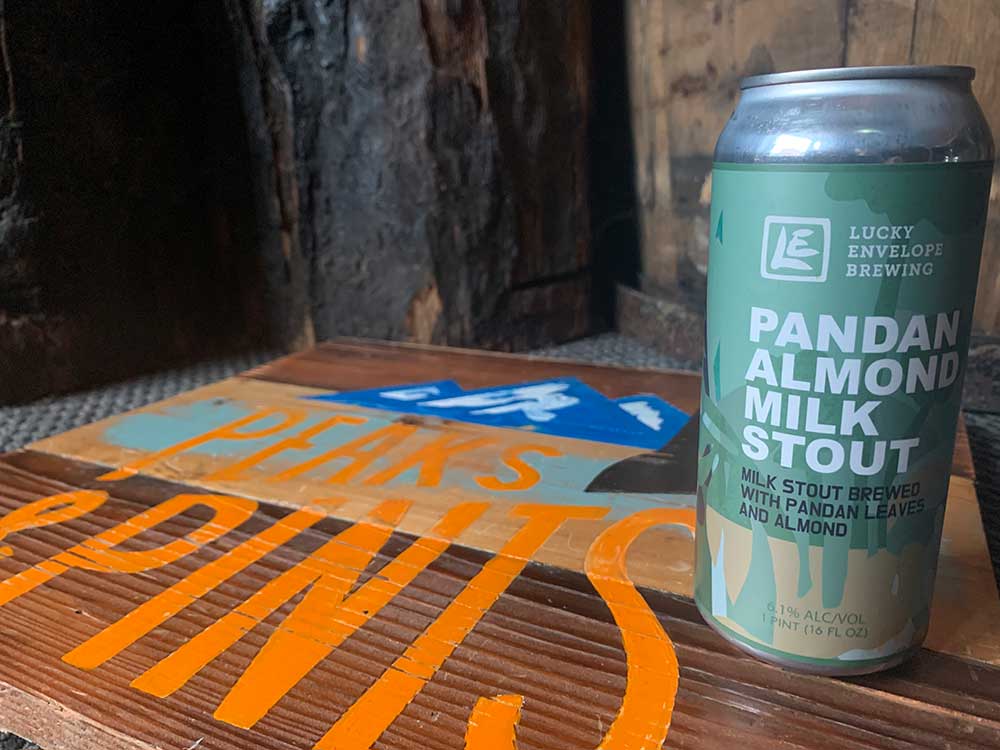 Lucky Envelope Pandan Almond Milk
Lucky Envelope Pandan Almond Milk
6.1% ABV
French pharmacist Jean Baptiste Alphonse Chevallier carried on significant research in analytical, biological, and legal chemistry. His most important contributions were in the areas of public health and hygiene, protection of the worker, occupational medicine, and adulteration of foodstuff. In 1856, Chevallier put forth in a French scientific journal the following theory: beer is good for you and milk is good for you, so beer with milk in it must be great for you. Those who were sick, beer and milk had been prescribed as a source of good calories to build them up. Unfortunately, milk + beer didn’t taste great. Adding sugar to beer became a good way to increase the caloric content of beer and made it taste better. To recap, adding milk to beer was considered a good idea but tasted bad, and adding sugar to beer was a good idea and tasted swell — so how about taking some of the parts of milk and adding them to beer? Enter lactose (milk sugar). John Henry Johnson in London patented a recipe for beer made with lactose and whey (byproducts of cheese making), but he never commercialized it. Then, just after the turn of the century, the first milk stout was sold. The style emphasizes a malty sweetness with hints of chocolate and caramel. They are sometimes called cream stouts or sweet stouts. Brewers intensified the dark, chocolaty malt body with lactose, hence why they’re more often called milk stouts. Brewer’s yeast can’t ferment lactose into alcohol, so it hangs around to give you a rich mouthfeel and a soft, creamy sweetness, balancing out the bitter and roasted qualities typical of its cousin stouts. Lucky Envelope Brewing’s Pandan Almond Milk offers the essence of the beloved Chinese almond tofu dessert and pandan in this comfort milk stout. They brewed with real pandan leaves and a hint of sweet almond for a velvety fusion with notes of vanilla custard, marzipan, and coconut. Allergen warning: It contains lactose and tree nuts.
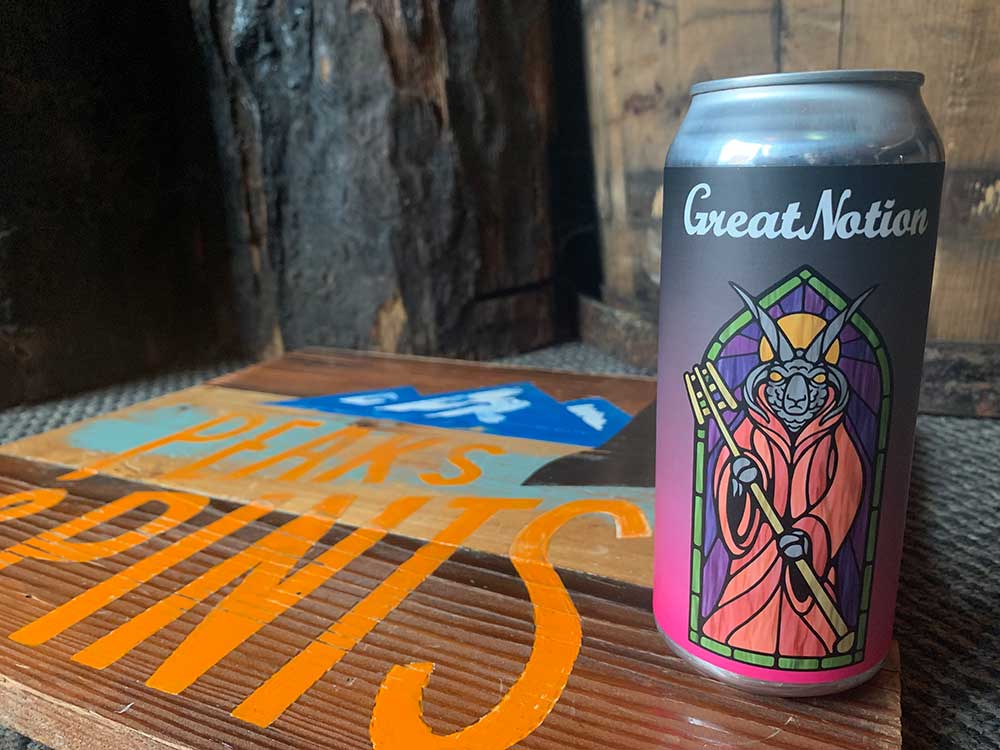 Great Notion Pink Sabbath
Great Notion Pink Sabbath
6.66% ABV
First made famous by Stone Brewing Company with the brewery’s release of Sublimely Self-Righteous IPA, the black IPA — or Cascadian dark ale, or American black ale, or India black ale — combines light flavors of roast and chocolate along with the forward hop aromas and flavors one would expect from a traditional IPA. Essentially, the style is a classic IPAs that has been “stained” with debittered black malts to create a mind-bending mix of intense hop flavor crossed with a stout-like appearance. In theory, this will create an exciting beer that’s pleasantly hoppy with a toasty richness. But, on the ground, there’s an uneasy truce and things get messy. It’s a challenging beer. Go too light with the malt bill, and it’s just a mangled IPA. Too dark, and you get a viciously astringent beer with strong notes of burning rubber. With the help of Steeplejack Beer and Pink Boots Society, Great Notion Brewing has taken a foray into the dark side of hops. This black IPA is an unholy union of rye malts and Chinook, Cascade, and Citra hops. It’s a little more malt-forward than most beers of this style, but the pine notes and roasty bitterness is there.
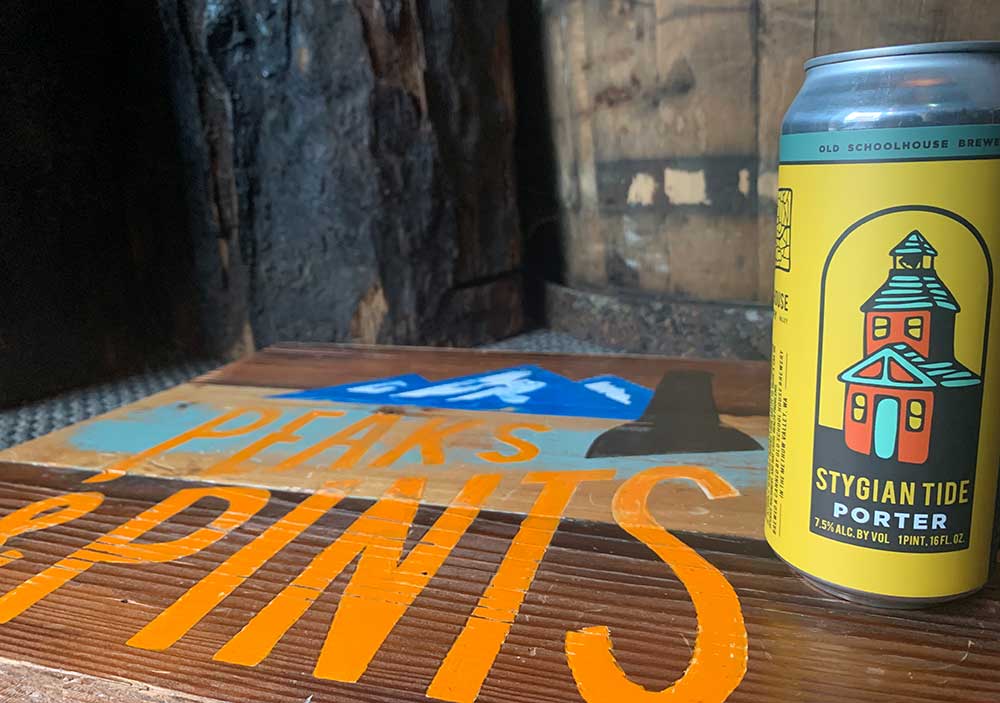 Old Schoolhouse Stygian Tide
Old Schoolhouse Stygian Tide
7.5% ABV
The imperial stout famously had its birth in the 18th century after England began sending an amplified, higher-alcohol version of domestic stouts to Russia to sate the taste of Peter the Great, who had recently visited the British Isles and taken a liking to local beer styles. The altered formula for the popular black beer was a tactic meant to protect the stout, stored in barrels, from freezing and bursting during the open sea voyages into sub-Arctic latitudes. England was also sending higher strength porters to the Baltic states. Over time, brewers in Scandinavia, Finland, Estonia, and neighboring nations began making their own porters — but with a local twist. They used lager yeast to brew what were traditionally rich, roasty ales. Lager yeast — S. pastorianus — works best at lower temperatures, and it ferments more slowly. The Baltic region being cold, lager yeast was a popular brewing tool for the region’s beer makers, and many of them began making dark black porters using the slow-fermenting culture. In 1977, beer writer Michael Jackson penned the existence of porter brewing in Poland in his World Guide to Beer. Jackson is credited with inventing the expression, “Baltic porter,” the name by which the style is now known, even in Poland. The Baltic porter is a dark black beer known for an assertive chocolate malt that imparts sweetness and often hints of toffee, licorice, and roastedness, and it can be quite strong, ranging from 7.6 to 9.3 percent. Old Schoolhouse Brewery’s version offers ripples of coffee and dark chocolate on a smooth, creamy body with a plum and dark fruits finish.
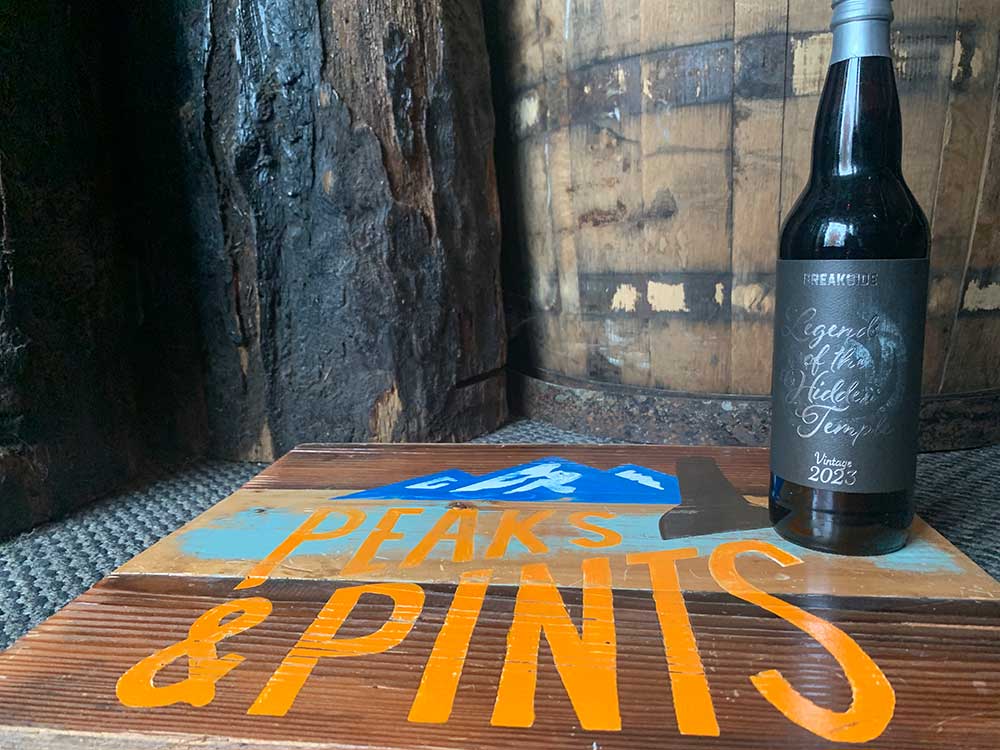 Breakside Legends of The Hidden Temple
Breakside Legends of The Hidden Temple
13.4% ABV
Barrel aging has been a thing for centuries. Before industrialization, Europeans fermented beer in wood, stored and shipped in wood, and poured directly from wood. Beer spoiled often. Life was hard. By the mid-20th century, most breweries had happily traded their temperamental wooden barrels for the reliability and convenience of metal tanks. Beer spoiled less. Life was decent. However, brewers have long known that wood-aging can add flavor and depth to beer, especially if said barrel previously contained Kentucky bourbon, Jamaican rum, or Washington state wine. Because it’s porous, wood allows for slow oxidation, which can make darker, malty beers more complex. The barrel’s former resident — the wine or whiskey or whatever that first made its home there — is also important. As a tenant, bourbon leaves the place smelling like vanilla, as does Cabernet Sauvignon, though to a lesser extent. Rum barrels soak up all that yummy, distilled sugar cane goodness for an aroma that is pure dark rum and flavor laced with sweet vanilla and spice notes. Breakside Brewery made an impressive blend of porters and stouts aged in several spent barrels that held impressive bourbons and whiskeys. Legends of The Hidden Temple is the fourth barrel-aged stout that Breakside has blended and released this year. This bourbon barrel-aged blend expresses deep wood notes, big vanillin, and a balance between spirituousness and viscosity — something that drinks both youthful and aged at the same time. The Portland brewery found a cohort of five casks of imperial porter that had been aged for more than 2 and a half years in former Van Winkle Bourbon barrels that had also been used to age maple syrup for deeply green and earthy whiskey notes coupled with the luscious and refined sweetness of true maple. Notes of butterscotch, honey, and green almond came to the forefront, and they sought to amplify those attributes with two casks of imperial rye stout for classic Bourbon caramel notes to the table, and some older porter casks for notes of smoke and baking spice.
LINK: Peaks & Pints beer and cider cooler inventory
